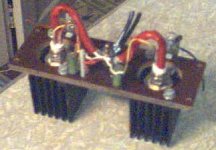I got from eBay a pair of thyristors from an old X-ray machine, and I can't figure out the configuration. They are very large, heatsinked, white ceramic body. Now, the only configurations with two thyristors I've seen are either antiparallel, making a triac, or in series, as part of a bridge. But the ones I have have one end, the same one on each, joined together; also, each one has a capacitor between this common point and their third terminals. WTF is this thing?
Thyristor configuration
Sounds like it's a controlled rectifier. From the pic, the joined cathode wires are the positive output, the anodes go to each end of the transformer, and the transformer centre tap is the (usually earthed) negative output. You *must* use a choke-input LC filter for this kind of setup to work properly. A simple capacitive file just will not work properly.
Sounds like it's a controlled rectifier. From the pic, the joined cathode wires are the positive output, the anodes go to each end of the transformer, and the transformer centre tap is the (usually earthed) negative output. You *must* use a choke-input LC filter for this kind of setup to work properly. A simple capacitive file just will not work properly.
The transformer I have is actually a pulse transformer intended to have switched 150 V on the primaries. I was thinking of using it in one of the pulse supply configurations in http://www.physiqueindustrie.com/Publi/solid_state_pulsed_power.pdf
I'm not sure if these thyristors are voltage rated for the secondary (80-120 kV). Searching for the markings gives results in parts lists websites, but no datasheets or other info; they are marked AEG T 130 N 1200 BOC-17X2. The thing was definitely not oil immersed, which probably means the voltage rating is not that high. Can I use these on the primary side, or are they not suitable? The huge wire gauge suggests big currents here.
Another pulsed configuration is in Figure 2 at http://hotta.es.titech.ac.jp/~ehotta/pdf/IEEE/SI-Thy2000.PDF but I don't know what the CT marking in the figure means, and how the pulse-shaping Blumlein line is chosen, i.e. where the 30 m length comes from.
I'm not sure if these thyristors are voltage rated for the secondary (80-120 kV). Searching for the markings gives results in parts lists websites, but no datasheets or other info; they are marked AEG T 130 N 1200 BOC-17X2. The thing was definitely not oil immersed, which probably means the voltage rating is not that high. Can I use these on the primary side, or are they not suitable? The huge wire gauge suggests big currents here.
Another pulsed configuration is in Figure 2 at http://hotta.es.titech.ac.jp/~ehotta/pdf/IEEE/SI-Thy2000.PDF but I don't know what the CT marking in the figure means, and how the pulse-shaping Blumlein line is chosen, i.e. where the 30 m length comes from.
- Status
- This old topic is closed. If you want to reopen this topic, contact a moderator using the "Report Post" button.
